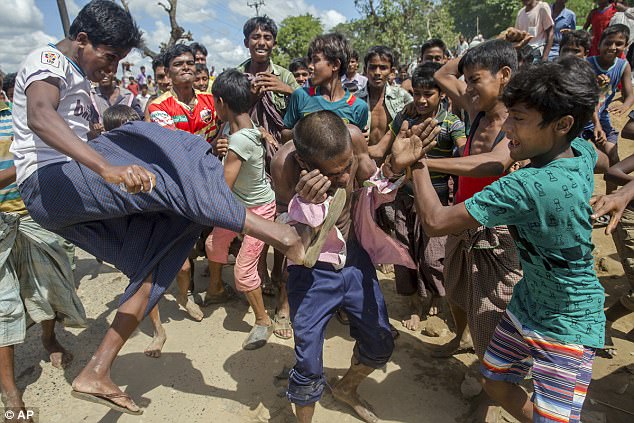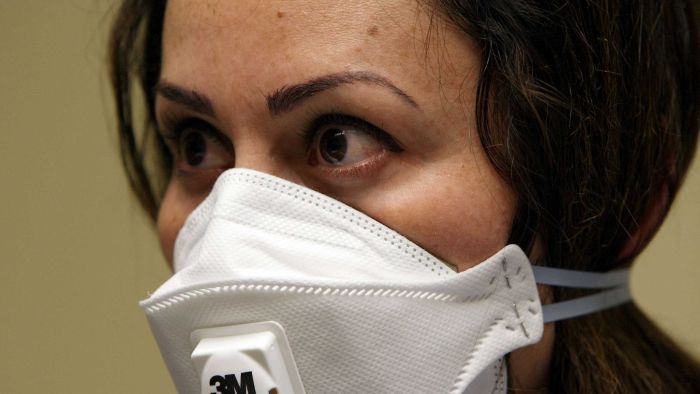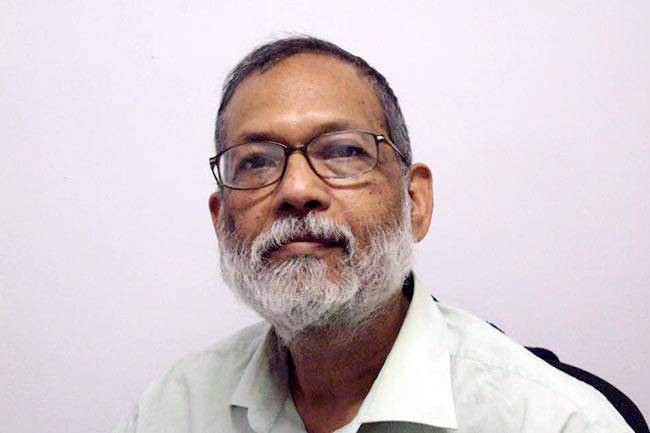Ameen Qudir
Published:2020-04-02 05:52:46 BdST
করোনা নিয়ে ভয়ের কারণ নেই, অভয় দিলেন বিশ্বখ্যাত চিকিৎসক নাগেশ্বর রেড্ডি
বিশ্ব জুড়ে সম্মানিত চিকিৎসক জি পি নাগেশ্বর রেড্ডি; ছবি দি নিউ ইন্ডিয়া এক্সপ্রেসের সৌজন্যে।
ডেস্ক
_________________
সারা বিশ্বে ভীতি ছড়ানো করোনাভাইরাস নিয়ে বরাভয় দিলেন এশিয়ান ইনস্টিটিউট অব গ্যাস্ট্রোএনটেরোলজির (এআইজি) চেয়ারম্যান ও পদ্মভূষণপ্রাপ্ত এবং বিশ্ব জুড়ে সম্মানিত চিকিৎসক জি পি নাগেশ্বর রেড্ডি। তিনি বলেছেন, এ ভাইরাসকে জয় করা সম্ভব। আর ভারতে দেওয়া তিন সপ্তাহের দেশব্যাপী লকডাউন আর বাড়ানোর প্রয়োজন নেই বলে মনে করেন তিনি। ভারতের ইংরেজি দৈনিক দ্য নিউ ইন্ডিয়ান এক্সপ্রেসকে দেওয়া এক দীর্ঘ সাক্ষাৎকারে তিনি এসব কথা বলেন। সাক্ষাৎকার নিয়েছেন পত্রিকাটির সম্পাদক জি এস ভাসু। ভাইরাসের জিনোম সিকোয়েন্সিং বা জীবনরহস্যের উন্মোচন এবং এর ওপর তাপমাত্রার প্রভাবের দুটো বিষয়ে তুলে ধরে আশার কথা শুনিয়েছেন তিনি। এ সাক্ষাৎকারের গুরুত্বপূর্ণ অংশ তুলে ধরা হলো দ্য নিউ ইন্ডিয়ান এক্সপ্রেস-র সৌজন্যে। এশিয়ান ইনস্টিটিউট অব গ্যাস্ট্রোএনটেরোলজির (এআইজি) দপ্তর হায়দরাবাদে অবস্থিত।
ভাসু: ভাইরাসের উৎস ও বিস্তার নিয়ে আপনি গবেষণা করেছেন। আপনার কি মনে হয় এটা ভারতের জন্য ঝুঁকির কারণ?
রেড্ডি: এর ইতিহাস যদি দেখেন, তবে এটি গত বছরের মধ্য ডিসেম্বরে চীনের উহানের সামুদ্রিক প্রাণীর একটি বাজারে এর উৎপত্তি হয়েছে। এরপর এটি ছড়িয়েছে। উহান থেকে এটি পশ্চিমে যুক্তরাষ্ট্র ও ইউরোপে ছড়িয়েছে। ছড়ানোর দুই থেকে তিন সপ্তাহের মধ্যে পরোক্ষভাবে এটি ভারতে এসেছে। তাই একে বুঝতে তিন থেকে চার সপ্তাহের একটা ফাঁক রয়ে গেছে। করোনাভাইরাস আরএনএ ভাইরাস। এ সুনির্দিষ্ট ভাইরাসটির সঙ্গে বাদুড়ের সম্পর্ক আছে। যদিও আমরা এখনো জানি না, এটি বাদুড় থেকে এসেছে কি না। তবে বাদুড় থেকে মানুষে ছড়াতে এর একটি ছোট পরিবর্তন ঘটেছে।
তবে সবচেয়ে গুরুত্বপূর্ণ হলো, এই ভাইরাস যখন ইতালি, যুক্তরাষ্ট্র বা ভারতে ছড়িয়েছে, তখন এর জিনগত কিছু বৈশিষ্ট্য পরিবর্তিত হয়েছে। চারটি দেশ—প্রথমে যুক্তরাষ্ট্র, পরে ইতালি, এরপর চীন এবং চতুর্থত, ভারতে এর জিনগত বৈশিষ্ট্য উন্মোচন করা হয়েছে। সেখানে দেখা গেছে, ইতালিতে ছড়ানো ভাইরাসের সঙ্গে ভারতে ছড়ানো ভাইরাসের ভিন্ন বৈশিষ্ট্য রয়েছে। এর গুরুত্ব অত্যধিক হতে পারে। কারণ, ভারতের ভাইরাসটির স্পাইক প্রোটিনে কিছু কিছু জিনগত পরিবর্তন হয়েছে। স্পাইক প্রোটিনের মাধ্যমেই ভাইরাসটি মানবশরীরের কোষে সংযুক্ত হয়। ভারতের ক্ষেত্রে কম যুক্ত হয়েছে, যার অর্থ, এটি দুর্বল হয়ে পড়েছে। এটা ভারতের জন্য একটি গুরুত্বপূর্ণ বিষয় হতে পারে।
সাক্ষাৎকারটির বিবরণ ও লিঙ্ক :::https://www.newindianexpress.com/lifestyle/health/2020/mar/29/no-need-to-panic-covid-19-is-something-we-can-easily-conquer-medical-expert-dr-d-nageshwar-reddy-2123093.html
No need to panic, COVID-19 is something we can easily conquer: Padma Bhushan Dr D Nageshwar Reddy
In a chat with The New Indian Express Editor GS Vasu, the internationally renowned medical expert shares two key findings that give India reason to hope.
HYDERABAD: At a time of paranoia and panic over how long this corona-fuelled lockdown may stretch, internationally-renowned medical expert Dr D Nageshwar Reddy has good news. "This is something we can easily conquer. There’s no need to panic,” he says, while adding that the current lockdown “should not prolong beyond 3-4 weeks”.
In a chat with The New Indian Express Editor GS Vasu, the Hyderabad-based gastroenterologist, who was awarded the Padma Bhushan in 2016 and who currently serves as the Chairman of the Asian Institute of Gastroenterology, shares two key findings that give India reason to hope - one emerging from a study on genome sequencing and another from research on the impact of temperature on the virus. He also elaborates on why he abhors the term social distancing and how staying positive could prove vital. Excerpts:
GS Vasu: You have studied the origin of the virus and the way it has spread. What, in your view, is the risk to India?
Dr N Reddy: If you look at its history, the virus originated sometime in the middle of December in China at a live seafood market and then spread to the Wuhan area. From the Wuhan area, it travelled to Western countries like Italy, the USA and Europe. With a lag of about two or three weeks, it came from these areas to India, indirectly. So, we had a gap of three or four weeks to study this virus.
Coronavirus is an RNA virus. This particular strain seems to be in bats but whether it directly came from the bat or not, we are still not sure. A small mutation occurred which allowed it to get transmitted from bats to humans. But the most important thing is that when this virus spread to say Italy or the US or to India, the genotypes of this virus turned out to be different. Sequencing of the whole virus has been done in four countries — the first in the USA, second in Italy, third in China and fourth in India.
What they are finding is that this virus has a different genome sequencing in India compared to say Italy. This has a lot of significance because in the Indian virus, there is a single mutation occuring in the spike protein of the genome. Spike protein is the area that attaches to the human cell. One small mutation has happened, making that attachment weak. So, this will become an important factor for us in India.
Whereas in the Italian virus, three mutations have occurred, making it more deadly to these people. In Italy, other aspects are also at play. The age of many patients being above 70-80 years, smoking, alcohol, comorbid conditions like diabetes, hypertension and so on. Therefore, with this combination, mortality levels are higher than usual, sometimes 10%. Whereas in India, in the USA, in China, the mortality is only about 2%. There is variation in mortality and infection rate based upon the genome of the virus. Host immunity is also playing a role.
So, in your view, the virus that has spread to India is less harmful than the one that has spread to other countries? Can that be said?
No, we can’t directly say that but what we can say is that there is a definite difference in the gene sequence and we are hoping that will result in the virus being less harmful because its attachment to the cell is not as good. But clinically, unless we do large-scale studies, we won’t know whether this is 100% true. But there is definitely a difference in the genotype.
There are contrarian views on the complete lockdown that we have imposed, doctor. Some feel we should have just shut the red zones while others are of the view that complete shutdown is the only solution. What are your thoughts on that?
So, this is a very controversial area. There are two extremes — one is complete shutdown, the other extreme is to keep everything open and test everybody. This is what South Korea did. Everything is still open in South Korea but they did extensive testing of the population and those people who are positive have been isolated quickly. This is called the red zone or selective isolation.
In our country, because of the demographics and because of the scale involved, extensive testing is not feasible. For us, the only alternative is to do a complete lockdown, which has been done. This also has economic consequences but I think the temporary lockdown of two or three weeks was a must at that point in time for the country. But after the lockdown time is over comes the crucial question -What should we do in the future?
There I think we should follow a more balanced approach, where we can do more testing now that the test kits are becoming cheap and easily available and do selective isolation. More important is that only certain people above a certain age and with comorbidities are having problems. So, those people must be extensively checked and isolated, and the younger population, which does not have comorbidities, can be left a little more free. But this only after this lockdown period is over. In my opinion, at present because of the fear of community spread, the lockdown is something that I think was essential although it has its economic consequences. But prolonged lockdown is going to be a big problem. We should limit it to three weeks.
That’s the maximum you feel it should be?
Yes, unless there is a high community spread that we still can’t control. But looking at the curves that we are getting now, it looks like, to some extent, the community spread is being controlled. In a country like ours, it is very difficult to have a complete lockdown for long periods because social unrest will increase.
From the time this virus has started spreading to our country, alongside the scientific evidence being put forth, we are also seeing a lot of unscientific stuff that is getting circulated on social media. Some are saying that the virus will not survive in hot weather, some are of the view that the young won’t get affected and that only if you are 60+, there is a high risk of death. There is fear, there is panic — maybe genuine, maybe unfounded. Can you kindly elaborate?
So, I think the first thing is there are a lot of myths and a lot of fake news is going around. The most important thing is that we should not panic. This is not such a dangerous situation that we should panic. We should not look at what is happening in Italy and France and think that this will happen here.
The second thing is that this virus, for some reason, does not affect children below the age of 10 years. There are some case reports but not so many.
And in the elderly, it is not the biological age that is important, it is the physical age. So, generally, above the age of 70 years, if somebody has comorbidities like diabetes, hypertension, cancer and so on, then this virus can attack in a more severe way. Otherwise, those who are above the age of 60-65 should not worry. For a normal person, as long as he/she is healthy, it does not cause any major issues.
The mortality rate, even among very old people in India, is still not as high as you see in Italy. So, I believe that the panic should go.
What is not being emphasised is mental health. That is becoming very important because of this panic. Thanks to this isolation and social distancing, people are developing psychiatric problems. Recently, the British Psychiatric Association had a paper that suggested that depression, alcoholism, home abuse, child abuse, suicide are all increasing because of this.
If the lockdown goes on for a long time, this becomes very important.
I think mental health is important because studies have shown that those who are mentally strong and happy, have strong immunity. If we get depressed, we are not happy. So, there are more chances of catching the virus infection. We should concentrate on that.
Positive messages should go to the public. Don’t worry, this lockdown is inevitable and enjoy your freedom during this time. I know with economic problems, other things will also come up but this has to be tackled at the government level.
Now, regarding temperature, there was and there is still a lot of controversy, but a paper was published by MIT, USA, where they have shown the heat-sensitivity of this virus. This virus is unable to exist for long periods above 32 degrees .
Now, this means several things. In India, it means that hopefully, as we progress into May — when the heat rises — maybe the virus transmission may come down. But indoors, where we are living in air-conditioning or where the temperature levels are cool, the problem still persists. So, temperature may have a role but it might start having an effect only after May.
Is this research conclusive?
The MIT research is peer-reviewed. It has not been completely published but the peer reviews look positive. There is some evidence that it is a heat-sensitive virus, which may be beneficial, but as I said, this is still preliminary data in an experimental lab. It is not clinically proven.
It might be a bit early to ask you, but do you suspect there could be behavioural change post the lockdown? What, in your view, are the precautions that people in general need to take?
I am already seeing these behavioural changes during the lockdown. People are becoming more paranoid, they are becoming withdrawn. I think communication is coming down. So, behavioural change is already seen and is going to increase. I think to counter this, we have to have a message which also gives true scientific facts about this virus because people are watching TV and hearing of people dying and are getting worried. I think we should give a clear indication of what is going to be the outcome of this virus.
Number two, it is difficult in our country but at least in Western countries, they have started home counselling. But I think ultimately, we have to give a positive message. We know that this is a problematic time but the message has to be positive so that the public in general don’t panic because we are already hearing incidents of suicide.
If you look at it, this is a small blip in human history. It is going to go out. In the next two to three months, we will get medicines and in the next 16 months, we will have a definite vaccine. So, by 2022, everybody will forget about the virus because the vaccine is available. But this one year is troublesome, we have to be very strong. There is nothing to panic about, this is something we can easily conquer.
There is also a view that even if it stops for now, there is a risk of recurrence, maybe a couple of months down the line or six months down the line. Is that a possibility?
All coronaviruses which have been seen before are seasonal in nature. The SARS virus, the MERS virus, the Swine Flu — these are all coronaviruses and they are seasonal
But with this lockdown, it is going to be only for one season because after this we are going to get a vaccine and it won’t be a problem anymore. What we have to guard against is the next season. Suppose this virus goes down by May/June, we have to be very careful in December, January, February because it might come again next year. What will happen by that time, in my opinion, is we might not only have medical treatment, but also testing will become cheap and widespread. So, isolation policies will become more formed and it won’t be like what is happening now and so widespread in nature.
If one is isolating, what are the basic precautions that we need to take?
One of the basic precautions of course is physical distancing — I believe the term social distancing should be replaced by physical distancing. We have to keep a distance of 1 metre from individuals when we are talking and so on. Hand hygiene is very important — now everybody is following hand hygiene. And also, there is strong talk of mobile hygiene. Mobile phones can carry this virus for 48 to 72 hours. So, we should see that we don’t take somebody else’s phone and use it. If you are, use a sanitiser to clean the phone or clean your hands before taking a new phone or giving someone your phone.
Second, we must maintain adequate nutrition. Vitamin C, zinc and vitamin D are very important to build immunity against this virus — you can take these three either as supplements or adequately in your diet.
Some minimal physical activity is important. You should not remain confined to only your house and room.
And of course, fourth is mental health — being positive.
These four things I think will help us a lot.
What are the lessons that, in your view, we need to take in terms of improving our public health infrastructure in light of what we have seen post the virus outbreak?
I think this is a big lesson for us but unfortunately there are also issues in terms of health infrastructure. It can’t be changed in just a few months or years. This is a very long process and it can sometimes take more than decades. You can see that in our country, compared to other countries, health infrastructure is definitely lacking especially when we are dealing with an epidemic like this. We have to work on it. We can’t do it on a massive scale like in other countries but at least we can improve by having more epidemiologists, and having in each state a centre that can deal with epidemics in a very specific way. Also, what will help is having hospitals that are specifically dedicated to epidemics and encouraging doctors and health workers to specialise in this area. So, I think all these are important steps.
Right now, I think our government’s actions have been positive. Hopefully, this will also lead them to develop at least a basic infrastructure to deal with epidemics like this in the long term.
আপনার মতামত দিন:









